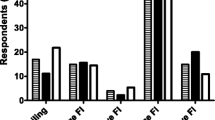Abstract
Introduction and hypothesis
We compared the prevalence of fecal incontinence between constipated and nonconstipated women and correlated its prevalence with the number of Rome III constipation symptoms.
Methods
We performed a cross-sectional survey to evaluate the prevalence of fecal incontinence and constipation among women who presented to two gynecologic clinics for routine care over a 24-month period. Fecal incontinence was defined as loss of well-formed and/or loose stool beyond the patient’s control that occurred at least once in the last 4 weeks, was bothersome, had been present for the past 3 or more months, and had affected the person’s activities, relationships, or feelings. Constipation was diagnosed using the Rome III criteria. Our study was exempt from institutional review board approval because it was a survey and did not ask for information that could be used to identify the participant.
Results
Mean age of the 2,319 participants was 50.1 ± 15 years and mean body mass index (BMI) was 28.7 ± 7. Seven hundred and twenty-five (31 %) women had constipation, and 233 (10 %) had fecal incontinence. One hundred and one (43 %) incontinent women had coexisting constipation. Logistic regression analysis identified white race (p = .013), menopause (p = .010), and constipation (p = .004) as risk factors for fecal incontinence. After controlling for these risk factors, constipated women were more likely to have fecal incontinence than nonconstipated women [relative risk (RR) 1.60, 95 % confidence interval (CI) 1.26–2.05]. In addition, the prevalence of fecal incontinence was strongly associated with the number of Rome III constipation symptoms (p < .001).
Conclusion
Constipation is an important risk factor for fecal incontinence.

Similar content being viewed by others
References
Nelson RL (2004) Epidemiology of fecal incontinence. Gastroenterology 126(Suppl 1):S3–S7
Whitehead WE, Norton NJ, Wald A (2004) Advancing the treatment of fecal and urinary incontinence through research. Gastroenterology 126(Suppl 1):S1–S2
Kamm MA (1994) Obstetric damage and faecal incontinence. Lancet 344:730–3
Karoui S, Leroi AM, Koning E, Menard JF, Michot F, Denis P (2000) Results of sphincteroplasty in 86 patients with anal incontinence. Dis Colon Rectum 43:813–20
Trowbridge ER, Morgan D, Trowbridge MJ, DeLancey JOL, Fenner DE (2006) Sexual function, quality of life, and severity of anal incontinence after anal sphincteroplasty. Am J Obstet Gynecol 195:1753–7
Malouf AJ, Chambers MG, Kamm MA (2001) Clinic and economic evaluation of surgical treatments for faecal incontinence. Br J Surg 88:1029–36
Halverson AL, Hull TL (2002) Long-term outcome of overlapping anal sphincter repair. Dis Colon Rectum 45:3451–8
Norton C, Chelvanayagam S, Wilson-Barnett J, Redfern S, Kamm MA (2003) Randomized controlled trial of biofeedback for fecal incontinence. Gastroenterology 125:1320–9
Scarlett Y (2004) Gastroenterology 126(Suppl 1):S55–63
Nelson R, Furner S, Jesudason V (1998) Fecal incontinence in Wisconsin nursing homes. Dis Colon Rectum 41:1226–9
Chassagne P, Landrin I, Neveu C, Czernichow P, Bouaniche M, Doucet J et al (1999) Fecal incontinence in the institutionalized elderly: Incidence, risk factors, and prognosis. Am J Med 196:185–90
Boreham MK, Richter HE, Kenton KS, Nager CW, Gregory WT, Aronson MP et al (2005) Anal incontinence in women presenting for gynecologic care: Prevalence, risk factors, and impact upon quality of life. Am J Obstet Gynecol 192:1637–42
Longstreth GF, Thompson WG, Chey WD, Houghton LA, Mearin F, Spiller RC (2006) Functional bowel disorders. Gastroenterology 130:1480–91
Vaizey CJ, Carapeti E, Cahill JA, Kamm MA (1999) Prospective comparison of fecal incontinence. Gut 44:77–80
Barber MD, Walters MD, Bump RC (2005) Short forms of two condition-specific quality-of-life questionnaire for women with pelvic floor disorders (PFDI-20 and PFIQ-7). Am J Obstet Gynecol 193:103–13
Bharucha A, Wald A, Enck P, Rao S (2006) Functional anorectal disorders. Gastroenterology 130:1510–8
Conflicts of interest
None
Author information
Authors and Affiliations
Corresponding author
Rights and permissions
About this article
Cite this article
Sze, E.H.M., Barker, C.D. & Hobbs, G. A cross-sectional survey of the relationship between fecal incontinence and constipation. Int Urogynecol J 24, 61–65 (2013). https://doi.org/10.1007/s00192-012-1851-7
Received:
Accepted:
Published:
Issue Date:
DOI: https://doi.org/10.1007/s00192-012-1851-7



